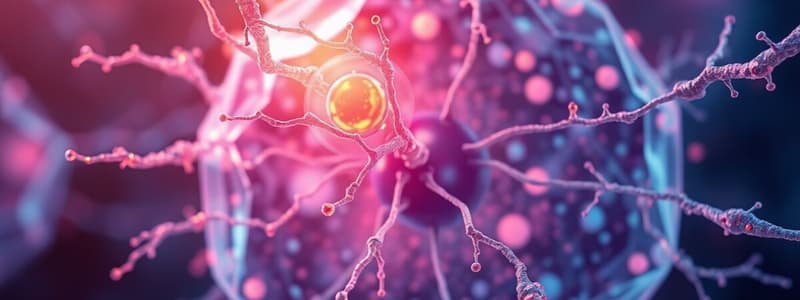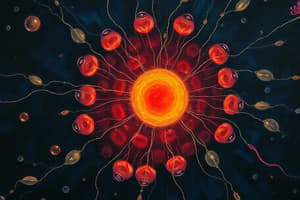Podcast
Questions and Answers
Which type of cytoskeleton fibers helps a cell change shape to fit into a space?
Which type of cytoskeleton fibers helps a cell change shape to fit into a space?
- Intermediate fibers
- Microtubules
- Microfilaments (correct)
- Actin fibers
What is the double membrane surrounding the nucleus called?
What is the double membrane surrounding the nucleus called?
- Nucleolus
- Nuclear wall
- Nuclear envelope (correct)
- Cytoplasmic membrane
Where in a cell are proteins primarily synthesized?
Where in a cell are proteins primarily synthesized?
- Endoplasmic reticulum
- Ribosomes (correct)
- Nucleus
- Golgi apparatus
Which organelle is responsible for modifying, sorting, and packaging proteins?
Which organelle is responsible for modifying, sorting, and packaging proteins?
Which of the following is found in both plant and animal cells?
Which of the following is found in both plant and animal cells?
What defines prokaryotic cells?
What defines prokaryotic cells?
Which statement is correct regarding colonial organisms?
Which statement is correct regarding colonial organisms?
Which of the following structures allows prokaryotes to attach to surfaces?
Which of the following structures allows prokaryotes to attach to surfaces?
What organelle moves proteins and other substances through the cell?
What organelle moves proteins and other substances through the cell?
Which cells are associated with photosynthesis?
Which cells are associated with photosynthesis?
Which type of molecule primarily forms the cell membrane?
Which type of molecule primarily forms the cell membrane?
What is the characteristic of phospholipids regarding their structure?
What is the characteristic of phospholipids regarding their structure?
Which process allows most polar molecules to pass through the cell membrane?
Which process allows most polar molecules to pass through the cell membrane?
Which mechanism does not require energy to transport substances across the cell membrane?
Which mechanism does not require energy to transport substances across the cell membrane?
What term describes the movement of water into or out of a cell?
What term describes the movement of water into or out of a cell?
How do ions typically move through ion channels in the cell membrane?
How do ions typically move through ion channels in the cell membrane?
What happens to a cell placed in an isotonic solution?
What happens to a cell placed in an isotonic solution?
What distinguishes active transport from passive transport methods?
What distinguishes active transport from passive transport methods?
Which of the following is a method for sugar molecules to cross the cell membrane?
Which of the following is a method for sugar molecules to cross the cell membrane?
What is the role of channel proteins in the cell membrane?
What is the role of channel proteins in the cell membrane?
Flashcards are hidden until you start studying
Study Notes
Cytoskeleton
- Microfilaments, microtubules, and intermediate fibers are three types of protein fibers that form the cytoskeleton.
- Microfilaments help a cell change shape to fit into a space.
Cell Structures
- DNA and some proteins are made in the nucleus.
- The double membrane surrounding the nucleus is called the nuclear envelope.
- Proteins are made on ribosomes.
- Bound ribosomes are located attached to membranes of another organelle.
- The endoplasmic reticulum moves proteins and other substances through the cell.
- The Golgi apparatus modifies, sorts, and packages proteins.
- A cell that requires a lot of energy might contain large numbers of mitochondria.
- Chloroplasts are the organelles associated with plant photosynthesis.
- Chloroplasts and mitochondria have in common the production of ATP.
- All the following are found in both plant and animal cells, except a cell wall.
Prokaryotic Cells
- Short, thick outgrowths that allow prokaryotes to attach to surfaces or each other are called pili.
- A bacterium is an example of a prokaryotic cell.
Levels of Organization
- The small intestine is an organ.
Colonial Organisms
- Colonial organisms are a collection of different kinds of cells.
Cell Membrane
- The cell membrane is made of phospholipids.
- Phospholipids are molecules that have one polar phosphate head and two nonpolar fatty acid tails.
- The interior of the lipid bilayer of a cell membrane forms a nonpolar zone that prevents most polar molecules from passing through the membrane.
- Diffusion is the movement of a substance from an area of high concentration to an area of lower concentration.
Transport Across the Cell Membrane
- Proteins that serve as tunnels for specific substances through the lipid bilayer are channel proteins.
- Sugar molecules cross the cell membrane by facilitated diffusion.
- Active transport requires energy.
- Ions move through ion channels by passive transport.
- The diffusion of water into or out of a cell is called osmosis.
- Osmosis is a type of passive transport.
- Water passes through the cell membrane through channel proteins just for water.
- An isotonic solution has the same solute concentration as the cytoplasm.
- Active transport requires energy and moves substances against their concentration gradient.
Studying That Suits You
Use AI to generate personalized quizzes and flashcards to suit your learning preferences.




